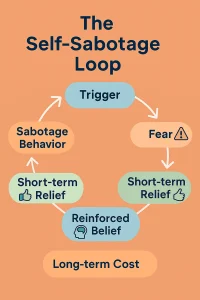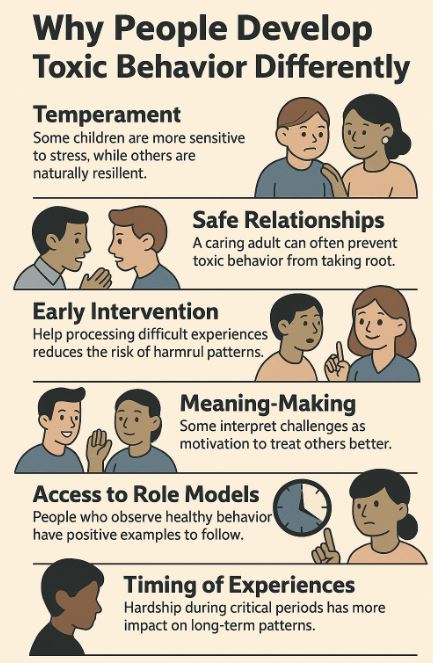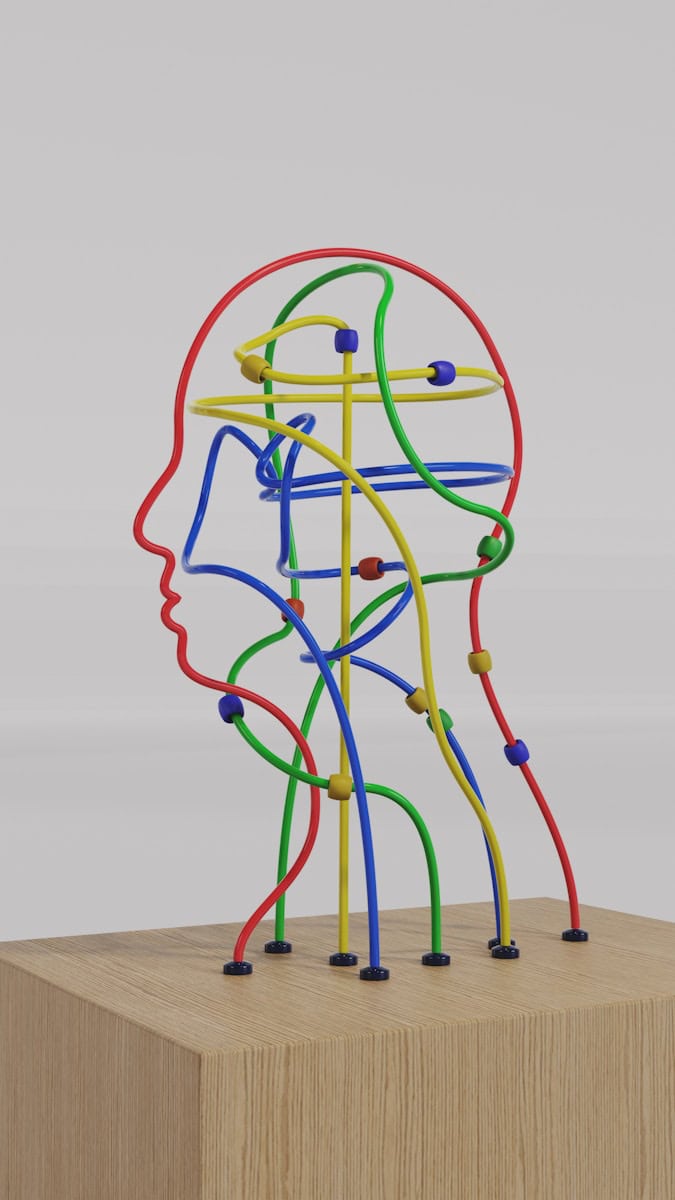Where Toxic Behavior Comes From: Childhood, Trauma, or Conditioning?
It made my head hurt trying to understand why my neighbor screams at cashiers. Why my coworker manipulates every conversation. Why some people hurt others repeatedly then act shocked when anyone calls their actions harmful.
Most people assume toxic behavior comes from bad character or moral failing. But research reveals something more complex. These patterns usually develop as survival strategies that made sense at one time, but no longer.
How Early Experiences Shape Behavioral Patterns
 Your brain develops most of its core programming during the first few years of life. The patterns you observe become the template for how you’ll handle similar situations decades later.
Your brain develops most of its core programming during the first few years of life. The patterns you observe become the template for how you’ll handle similar situations decades later.
Children who grow up in chaotic environments often develop toxic behavior around control. Their developing brains learn that unpredictable emotions are normal ways to navigate relationships. That aggressive responses are acceptable.
A four-year-old watching their parent explode in anger learns something important. They learn that rage is an acceptable response to disappointment. They practice this pattern thousands of times before they’re old enough, old enough to question whether it actually works effectively.
The same process happens with other forms of toxic behavior patterns. Kids who experience manipulation learn to manipulate others. Children who are criticized constantly become critical adults. Those who witness emotional unavailability often struggle with intimacy later.
But here’s what’s tricky about this process of development. The toxic behavior that develops isn’t random or purposeless. It usually serves specific functions that helped the child cope. Cope with their particular family environment and circumstances.
Maybe aggressive outbursts were the only way to get attention. The only way to get attention in a neglectful household. Perhaps manipulation was necessary to avoid punishment from unpredictable parents. Emotional shutdown might have protected a sensitive child from overwhelming family chaos.
These strategies often work well enough in childhood to become deeply ingrained and part of their ‘dna’, so to speak. They become automatic responses that the brain treats as successful solutions.
The problem comes later when these childhood survival strategies get applied to adult situations where they’re no longer appropriate or effective. The same behaviors that once provided protection now create problems in relationships and work that didn’t exist before.
Studies show that early trauma, especially during childhood, plays a significant role in shaping emotional regulation and interpersonal behavior. Harvard Health explains how trauma affects lifelong behavior patterns.
The Role of Trauma in Creating Toxic Behavior
 Trauma doesn’t just create painful memories, it actually changes how the brain processes threats, emotions, and relationships. These neurological changes often manifest as toxic behavior patterns. Patterns that feel automatic and uncontrollable to the person.
Trauma doesn’t just create painful memories, it actually changes how the brain processes threats, emotions, and relationships. These neurological changes often manifest as toxic behavior patterns. Patterns that feel automatic and uncontrollable to the person.
When someone experiences overwhelming events their system can’t process, the brain develops protective mechanisms. Mechanisms designed to prevent similar harm in the future.
A person who experienced betrayal might develop toxic behavior around trust and control. They become hypervigilant about others’ motives in every interaction. Questioning everything and trying to control outcomes to avoid being hurt again.
Someone who experienced abandonment might develop toxic behavior around attachment. They either cling desperately to relationships or push people away. Push people away before they can be rejected, I mean the best way not to be rejected is to reject them first, right? Both strategies feel protective but actually create the very abandonment they fear.
Trauma responses become toxic behavior when the brain treats current relationships like past threats. A partner asking a simple question triggers the same defensive response.
The person isn’t consciously choosing to be harmful to others. Their nervous system is running programs designed for survival during trauma, not connection during safety. But the impact on others is still real and damaging.
This explains why toxic behavior often seems disproportionate to what is happening. Someone explodes over minor inconveniences because their brain is responding to much bigger threats from the past that haven’t been properly processed.
Understanding trauma’s role doesn’t excuse toxic behavior in any way. But it helps explain why logic and consequences often fail. Fail to change these patterns effectively. The behavior is driven by parts of the brain that operate below conscious awareness. These patterns are totally unconscious.
How Social Conditioning Creates Harmful Patterns
Beyond individual trauma, entire cultures can condition people toward toxic behavior. Through the messages they send about power, relationships, and acceptable ways, acceptable ways to get needs met in society.
Growing up in environments that normalize aggression teaches children that these behaviors are standard relationship tools. They learn toxic behavior not through direct trauma necessarily. But through constant exposure to harmful patterns presented as normal.
Media and social influences also shape behavioral patterns through repeated exposure. Exposure to toxic dynamics presented as normal or even admirable. Characters who use manipulation to get what they want seem successful. Relationships built on control and jealousy seem romantic.
Many people develop toxic behavior because they’re following cultural scripts about how to be strong, successful, or attractive. The behavior feels normal because it’s modeled everywhere around them.
Professional environments can condition toxic behavior by rewarding harmful patterns. Workplaces that promote people who use intimidation teach employees something
Family systems often pass down toxic behavior patterns across generations, without anyone questioning whether these approaches actually work. Parents model the same harmful behaviors they learned from their parents. Creating cycles that persist for decades.
Social conditioning around gender, race, class, and other identities can also create patterns. People learn to use aggression, manipulation, or other harmful strategies. The conditioning becomes so deep that people don’t recognize their behavior as toxic. It feels like normal human interaction because it’s what they’ve always known.
Breaking free from conditioned toxic behavior requires recognizing something important. Just because something is common doesn’t mean it’s healthy or necessary. Many patterns that feel normal are actually learned responses. Learned responses that can be changed with effort.
Why Some People Develop Toxic Behavior While Others Don’t
 Two children can grow up in the same difficult household. They can develop completely different behavioral patterns despite similar experiences. One becomes harmful to others while the other remains kind and emotionally available throughout their life.
Two children can grow up in the same difficult household. They can develop completely different behavioral patterns despite similar experiences. One becomes harmful to others while the other remains kind and emotionally available throughout their life.
Research suggests that individual temperament influences outcomes significantly. Resilience factors and specific coping strategies all influence whether someone develops toxic behavior, in response to challenging experiences during development.
Some children are naturally more sensitive to environmental stress, while others seem naturally resilient to difficult circumstances. These differences affect how deeply harmful experiences impact their developing behavioral patterns.
The presence of even one consistently safe relationship can protect children from developing toxic behavior even in otherwise difficult environments. A grandparent, teacher, or family friend who provides emotional stability. Who can prevent harmful patterns from taking root.
Early intervention also matters significantly in developmental outcomes. Children who receive help processing difficult experiences are less likely to develop toxic behavior patterns later in life. Those who don’t get support often carry unprocessed emotions that fuel harmful behaviors for decades.
Individual meaning-making plays a crucial role too in development. Some people interpret difficult experiences as evidence that they need protection, others see the same experiences as motivation to treat people better. Better than they were treated themselves.
Access to healthy behavioral models makes a difference as well. People who observe positive relationship patterns have alternatives to fall back on, when stressed or challenged. Those who only witness toxic behavior have fewer options for responding to challenges effectively.
The timing of difficult experiences matters too for long-term impact. Trauma or conditioning that happens during critical developmental periods tends to have more lasting impact.
Finally, the availability of resources for healing makes a significant difference. People with access to therapy, supportive communities, and personal growth opportunities are more likely to change toxic behavior patterns than those without these resources.
Breaking the Cycle: From Understanding to Change
Recognizing where toxic behavior comes from is the first step. The first step toward changing it for people who want different patterns. But understanding alone isn’t enough to create lasting transformation.
People need specific strategies for rewiring the patterns that no longer serve them. The most effective approaches address toxic behavior at multiple levels. The nervous system responses, the thought patterns, the emotional regulation skills. And the behavioral choices themselves.
Nervous System Regulation
Nervous system regulation comes first because people can’t change patterns while their brains are stuck in survival mode. This involves practices like deep breathing and progressive muscle relaxation.
Healthier alternative: Practice 4-7-8 breathing when triggered. Breathe in for 4 counts, hold for 7, exhale for 8. This activates your parasympathetic nervous system.
Trauma Processing
Trauma processing helps people work through the original experiences that created defensive patterns. This usually requires professional support from therapists trained in trauma-informed approaches. Approaches like EMDR or somatic therapy that address stored trauma.
Healthier alternative: Seek therapy that specializes in trauma recovery rather than trying to process difficult experiences alone.
Developing Emotional Regulation Skills
Developing emotional regulation skills gives people alternatives to toxic behavior when they’re triggered. Tolerating discomfort and expressing needs directly prevents harmful patterns from taking over.
Healthier alternative: Practice naming emotions specifically rather than just feeling “bad” or “upset.” This helps your brain process feelings more effectively.
Building Secure Relationships
Building secure relationships provides the safe environment necessary for changing deep behavioral patterns. Having people who can offer honest feedback without judgment creates conditions for genuine growth and lasting change.
Healthier alternative: Seek relationships with people who model healthy communication and emotional regulation rather than trying to change in isolation.
The Neuroscience Behind Toxic Behavior Development
 Understanding how toxic behavior develops in the brain helps explain why these patterns feel automatic. Why they’re often resistant to logical intervention or willpower alone.
Understanding how toxic behavior develops in the brain helps explain why these patterns feel automatic. Why they’re often resistant to logical intervention or willpower alone.
When children repeatedly experience or witness harmful behaviors, their brains literally wire themselves to expect and prepare for those patterns. Neural pathways strengthen through repetition until toxic responses become the default way of handling stress or conflict.
The amygdala processes threats and emotions in your brain. It becomes hyperactive in people who’ve experienced trauma or chronic stress. This makes them more likely to interpret neutral situations as threatening, and respond with defensive behaviors that others experience as toxic.
Meanwhile, the prefrontal cortex handles rational thinking and emotional regulation. But it often becomes less active in people with trauma histories. This makes it harder to pause and choose healthier responses.
Stress hormones like cortisol can remain elevated in people with histories of trauma. These chemicals create a constant state of hypervigilance that makes toxic behavior more likely.
The brain’s reward system also gets involved when toxic behavior successfully meets needs. If aggression gets attention, manipulation achieves goals, or emotional withdrawal provides relief, these patterns get reinforced through dopamine release.
The good news is that neuroplasticity means these patterns can change. Change throughout life when people have the right support. And consistently practice new responses. The same brain mechanisms that create toxic behavior can create healthier patterns, when directed consciously.
Conclusion
Toxic behavior doesn’t emerge from nowhere. It develops through specific experiences, conditioning, and brain changes that made these patterns feel necessary for survival or success at some point.
Whether rooted in childhood trauma, cultural conditioning, or other factors, these behaviors served functions. Functions that felt important to the people who developed them. Understanding this creates compassion without excusing harm.
The origins of toxic behavior matter because they point toward effective interventions. Patterns that developed through trauma need trauma-informed healing. Behaviors learned through conditioning need new learning experiences and practice.
Most importantly, understanding where toxic behavior comes from reveals that change is possible. These patterns aren’t permanent personality traits but learned responses that can be unlearned with the right support and consistent effort.
The Hidden Pain Behind Toxic Traits: Where They Come From (Part 2)






